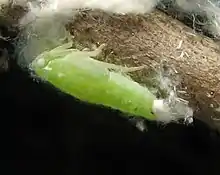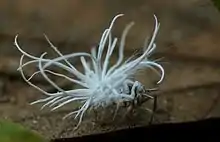Flatidae
Flatidae are a family of fulgoroid planthoppers. They are cosmopolitan in distribution and are distinguished from others in the superfamily by a combination of characters. Like all other planthoppers, they suck phloem sap of plants. Some species are known to communicate with vibrations through the plant stems.[1] Communication may be with mates, or with ants that tend the nymphs, protecting them and gathering honeydew secretions.[2] Adults of some species have brightly coloured forewings which are tougher and known as tegmina unlike the membranous hindwings which are used for flight. Although a few can be identified by their coloration, most species requires dissection and examination under a microscope with access to literature on already described species.[3]
| Flatidae | |
|---|---|
.jpg.webp) | |
| adult bugs and nymphs (Flatida rosea) Ankarana Reserve, Madagascar | |
| Scientific classification | |
| Domain: | Eukaryota |
| Kingdom: | Animalia |
| Phylum: | Arthropoda |
| Class: | Insecta |
| Order: | Hemiptera |
| Suborder: | Auchenorrhyncha |
| Infraorder: | Fulgoromorpha |
| Superfamily: | Fulgoroidea |
| Family: | Flatidae |
| Subfamilies | |

There are two subfamilies within the family. In the subfamily Flatinae, the body of adults is flattened laterally and the tegmina are tent-like. In the Flatoidinae, the body is not laterally compressed and the tegmina are not as tent-like and sometimes held horizontally. The wing venation is distinctive in that the veins in the anal region are nodose, and the costal area has numerous cross veins.[4] The antennae are small and the first segment is collar-like and small. The second segment is longer and ends in a bulge and a flagellum arises from it. They have two ocelli. Nymphs have a tail of waxy filaments.
Subfamilies and genera
Genera within the family Flatidae include:[5][6]
Flatinae
Auth.: Spinola, 1839; selected genera:
- tribe Ceryniini Distant, 1906
- Adelidoria Metcalf, 1952
- Adexia Melichar, 1901
- Bythopsyrna Melichar, 1901
- Cerynia Stål, 1862
- tribe Flatini Spinola, 1839
- subtribe Flatina Spinola, 1839
- Flata Fabricius, 1798
- Flatomorpha Melichar, 1901
- subtribe Lawanina Melichar, 1923
- subtribe Phyllyphantina Melichar, 1923
- Paracromna Melichar, 1901
- Phyllyphanta Amyot & Audinet-Serville, 1843
- subtribe Scarpantina Melichar, 1923
- Scarpanta Stål, 1862
- Scarpantina Melichar, 1901
- subtribe Siphantina Melichar, 1923
- Siphanta Stål, 1862
- tribe Nephesini Distant, 1906
- subtribe Cryptoflatina Melichar, 1923
- Cryptoflata Melichar, 1901
- Metcalfa Caldwell & Martorell, 1951
- Ormenaria Metcalf & Bruner, 1948
- Ormenoides Melichar, 1923
- subtribe Nephesina Distant, 1906
- Neomelicharia Kirkaldy, 1903
- Nephesa Amyot & Audinet-Serville, 1843
- subtribe Phaedolina Melichar, 1923
- Phaedolus Karsch, 1890
- subtribe Pseudoflatina Melichar, 1923
- Caesonia Stål, 1866
- Colgar Kirkaldy, 1900
- Colgaroides Distant, 1910 - Planthoppers
- Dalapax Amyot & Audinet-Serville, 1843
- Gyaria Stål, 1862
- Gyariella Schmidt, 1924
- Pauliana Lallemand, 1950
- Rhinophantia Melichar, 1901
- tribe Phantiini Melichar, 1923
- Mesophantia Melichar, 1901
- Microflata Melichar, 1901
- Phantia Fieber, 1866
- tribe Phromniini Distant, 1906
- Dermoflata Melichar, 1901
- Flatida White, 1846 (= Phromnia Stål, 1862)
- Flatina Melichar, 1901
- Flatosoma Melichar, 1901
- Paraflata Melichar, 1901
- Poeciloflata Melichar, 1901
- tribe Poekillopterini Kirkaldy, 1907
- Poekilloptera Latreille, 1796
- tribe Selizini Distant, 1906
- Jamella Kirkaldy, 1906 (J. australiae, or pandanus planthopper, pest to Pandanus tectorius[7][8])
- Seliza Stål, 1862
- tribe Sisciini Melichar, 1923
- Siscia Stål, 1870
Flatoidinae
Auth.: Melichar, 1901
- Atracis Stål, 1866
- Atracodes Melichar, 1902
- Bochara Distant, 1906
- Cerfennia Stål, 1870
- Cisatra Melichar, 1923
- Dendrona Melichar, 1923
- Flataloides Metcalf, 1938
- Flatarina Metcalf & Bruner, 1948
- Flatarissa Metcalf & Bruner, 1948
- Flatoides Guérin-Ménéville, 1844
- Flatoidessa Melichar, 1923
- Flatoidinus Melichar, 1923
- Flatosaria Melichar, 1923
- Franciscus Distant, 1910
- Gaja Distant, 1906
- Lichena Melichar, 1901
- Lichenopsis Schmidt, 1912
- Melichitona Metcalf, 1952
- Paraflatoides Melichar, 1923
- Phalaenomorpha Amyot & Audinet-Serville, 1843
- Porophloeus Melichar, 1902
- Pseudoflatoides Metcalf, 1938
- Uxantis Stål, 1870
- Uysanus Distant, 1908
incertae sedis
- Afrexoma Fennah, 1976
- Afrophantia Fennah, 1958
- Afrormenis Fennah, 1958
- Amasha Medler, 1992
- Anatracis Fennah, 1958
- Anzora Medler, 1986
- Bahuflata Dlabola, 1979
- Betracis Medler, 1988
- Boretsis Medler, 1996
- Brysora Medler, 2000
- Budginmaya Fletcher & Moir, 2009
- Catracis Medler, 1988
- Comnar Medler, 1988
- Cromgar Medler, 2000
- Cromnella Fennah, 1969
- Cryomna Medler, 2000
- Cyclopterum Gnezdilov & O'Brien, 2014
- Demina Medler, 2000
- Desanta Medler, 2000
- Diastracis Medler, 1988
- Dixamflata Stroinski, Malenovský & Swierczewski, 2016
- Dworena Medler, 1986
- Erotana Medler, 2000
- Eugyaria Synave, 1962
- Falcophantis Fletcher, 1988
- Garanta Medler, 2000
- Humgar Medler, 2001
- Ijagar Medler, 2000
- Insulume Medler, 1999
- Karrama Medler, 1988
- Kesaflata Stroinski, Malenovsky & Swierczewski, 2016
- Kirkamflata Swierczewski, Malenovsky & Stroinski, 2014
- Lasura Medler, 1992
- Lemaria Medler, 1988
- Madoxychara Stroinski & Swierczewski, 2013
- Malleja Medler, 1990
- Menora Medler, 1999
- Metcracis Medler, 1993
- Miniscia Medler, 1991
- Narowalenus Shakila, 1991
- Neocalauria Synave, 1957
- Neomistaria Yang & Chen, 2015
- Neosephena Medler, 2000
- Neovariata Shakila, 1984
- Ortracis Medler, 1996
- Paracalauria Synave, 1962
- Parasiphanta Fletcher, 1988
- Perinetella Synave, 1956
- Persepolia Dlabola & Safavi, 1972
- Peyrierasus Stroinski & Swierczewski, 2013
- Phaiophantia Lindberg, 1958
- Planata Medler, 1999
- Riodeorolix Lindberg, 1956
- Safroka Medler, 2001
- Samcerus Medler, 1993
- Saurana Medler, 1992
- Scarpuna Medler, 2006
- Shadaka Medler, 2000
- Soares Stroiński & Świerczewski, 2012
- Sogalabana Stroiński & Świerczewski, 2014
- Sosephena Medler, 1990
- Staliana Medler, 1988
- Stenume Medler, 1999
- Talopsus Medler, 1989
- Taparella Medler, 1989
- Tisia Dlabola, 1981
- Tormenis Medler, 1999
- Trisephena Medler, 1990
- Umidena Medler, 1992
- Walena Medler, 1999
References
- Virant-Doberlet, Meta; Žežlina, Ivan (2007). "Vibrational Communication of Metcalfa pruinosa (Hemiptera: Fulgoroidea: Flatidae)" (PDF). Ann. Entomol. Soc. Am. 100 (1): 73–82. doi:10.1603/0013-8746(2007)100[73:VCOMPH]2.0.CO;2.
- Pfeiffer, Martin; Linsenmair,K.E. (2007). "Trophobiosis in a tropical rainforest on Borneo: giant ants Camponotus gigas (Hymenoptera: Formicidae) herd wax cicadas Bythopsyrna circulata (Auchenorrhyncha: Flatidae)". Asian Myrmecology. 1: 105–119.
- Stephen W. Wilson (2005). "Keys to the families of Fulgoromorpha with emphasis on planthoppers of potential economic importance in the Southeastern United States (Hemiptera: Auchenorrhyncha)". Florida Entomologist. 88 (4): 464–481. doi:10.1653/0015-4040(2005)88[464:kttfof]2.0.co;2.
- F. Muir (1923). "On the classification of the Fulgoroidea (Homoptera)" (PDF). Proceedings of the Hawaiian Entomological Society. 5 (2): 205–247.
- Bourgoin Th. (2013) Hemiptera Database - FLOW (Fulgoromorpha Lists on The Web): a world knowledge base dedicated to Fulgoromorpha. Version 8.
- BioLib.cz: family Flatidae Spinola, 1839 (retrieved 29 August 2020)
- "The insects killing Fraser Island's pandanus population". Queensland Times. 26 January 2017. Retrieved 4 January 2021.
- Coghill, Jon (29 October 2015). "Rangers turn to tiny native wasp to save Fraser Island's iconic pandanus population". ABC News. Australian Broadcasting Corporation. Retrieved 4 January 2021.
External links
- Pictures of Australian Flatidae genera
- Illustrated overview of Fulgoroidea
 Media related to Flatidae at Wikimedia Commons
Media related to Flatidae at Wikimedia Commons
